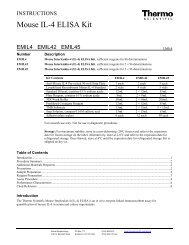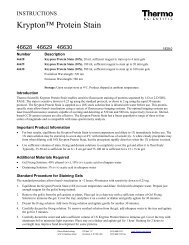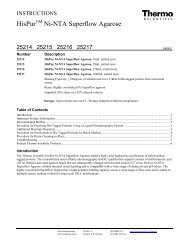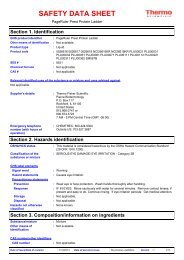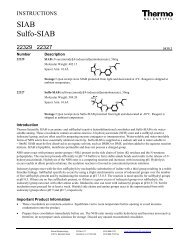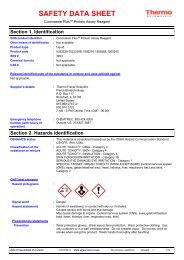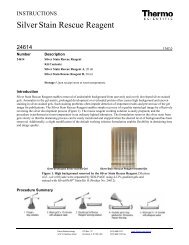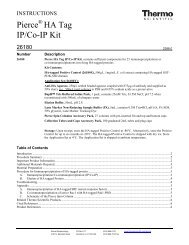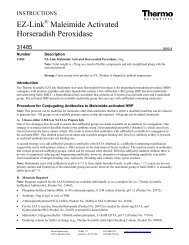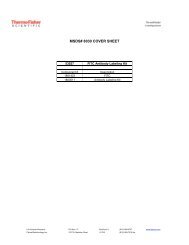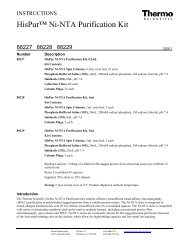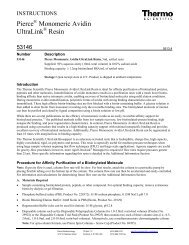Pierce Co-Immunoprecipitation (Co-IP) Kit
Pierce Co-Immunoprecipitation (Co-IP) Kit
Pierce Co-Immunoprecipitation (Co-IP) Kit
You also want an ePaper? Increase the reach of your titles
YUMPU automatically turns print PDFs into web optimized ePapers that Google loves.
Procedure for <strong>Co</strong>-<strong>Immunoprecipitation</strong><br />
A. Antibody Immobilization<br />
Note: The following protocol is for coupling 10-75µg of affinity-purified antibody in a solution free of amines and<br />
carrier proteins (see the Important Product Information Section). Scale this protocol as needed; see Table 1 in the<br />
Important Product Information Section for suggested antibody and resin volumes.<br />
1. Equilibrate the AminoLink Plus <strong>Co</strong>upling Resin and reagents to room temperature.<br />
2. Prepare 2mL of 1X <strong>Co</strong>upling Buffer for each co-<strong>IP</strong> reaction by diluting the 20X <strong>Co</strong>upling Buffer with ultrapure water.<br />
3. Gently swirl the bottle of AminoLink Plus <strong>Co</strong>upling Resin to obtain an even suspension. Using a wide-bore or cut<br />
pipette tip, add 50µL of the resin slurry into a <strong>Pierce</strong> Spin <strong>Co</strong>lumn. Place column into a microcentrifuge tube and<br />
centrifuge at 1000 × g for 1 minute. Discard the flow-through.<br />
4. Wash resin twice by adding 200µL of 1X <strong>Co</strong>upling Buffer, centrifuge and discard the flow-through.<br />
5. Gently tap the bottom of the spin column on a paper towel to remove any excess liquid and insert the bottom plug.<br />
6. Prepare 10-75µg of affinity-purified antibody for coupling by adjusting the volume to 200µL, using sufficient ultrapure<br />
water and 20X <strong>Co</strong>upling Buffer to produce 1X <strong>Co</strong>upling Buffer. For example add 10µL of 20X <strong>Co</strong>upling Buffer, 180µL<br />
of ultrapure water and 10µL of antibody at 1µg/1µL. Add the ultrapure water, 20X <strong>Co</strong>upling Buffer and affinity-purified<br />
antibody directly to the resin in the spin column.<br />
7. In a fume hood, add 3µL of the Sodium Cyanoborohydride Solution for every 200µL of reaction volume.<br />
Note: Sodium cyanoborohydride is highly toxic. Wear gloves and use caution when handling.<br />
8. Attach the screw cap to the column and incubate on a rotator or mixer at room temperature for 90-120 minutes, ensuring<br />
that the slurry remains suspended during incubation.<br />
9. Remove and retain the bottom plug and loosen the screw cap. Place the spin column into a collection tube and centrifuge.<br />
Save the flow-through to verify antibody coupling.<br />
10. Remove the screw cap, add 200µL of 1X <strong>Co</strong>upling Buffer, centrifuge and discard the flow-through. Repeat this step<br />
once.<br />
11. Add 200µL of Quenching Buffer to the column, centrifuge and discard the flow-through.<br />
12. Tap the bottom of the column on a paper towel to remove excess liquid and insert the bottom plug. Add 200µL of<br />
Quenching Buffer to the resin.<br />
13. In a fume hood, add 3µL of Sodium Cyanoborohydride Solution and attach the screw cap. Incubate for 15 minutes with<br />
gentle shaking or end-over-end mixing.<br />
14. Remove plug and loosen the screw cap. Place spin column in a collection tube, centrifuge and discard the flow-through.<br />
15. Remove screw cap, wash the resin twice with 200µL of 1X <strong>Co</strong>upling Buffer, centrifuging after each wash.<br />
16. Wash the resin six times with 150µL of Wash Solution, centrifuging after each wash.<br />
17. Either proceed to cell lysis and co-<strong>IP</strong> or, if storing the resin, proceed to the next step.<br />
18. Wash the resin twice with 200µL of 1X <strong>Co</strong>upling Buffer, centrifuging after each wash.<br />
19. Tap the column on a paper towel to remove excess liquid and place plug in bottom of spin column. Add 200µL of 1X<br />
<strong>Co</strong>upling Buffer, attach the screw cap and store column at 4°C. For long-term storage, add sodium azide to a final<br />
concentration of 0.02%.<br />
B. Mammalian Cell Lysis<br />
Protocol I: Lysis of Cell Monolayer (Adherent) Cultures<br />
1. Carefully remove culture medium from cells.<br />
2. Wash the cells once with 1X Modified Dulbecco’s PBS.<br />
3. Add ice-cold <strong>IP</strong> Lysis/Wash Buffer (Table 2) to the cells. Incubate on ice for 5 minutes with periodic mixing.<br />
<strong>Pierce</strong> Biotechnology PO Box 117 (815) 968-0747 www.thermoscientific.com/pierce<br />
3747 N. Meridian Road Rockford, lL 61105 USA (815) 968-7316 fax<br />
3



